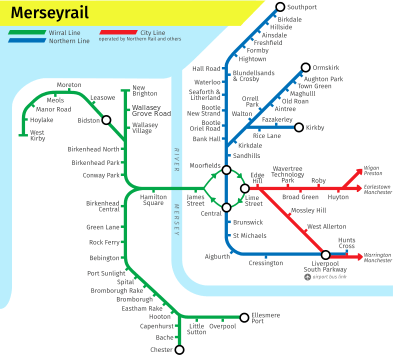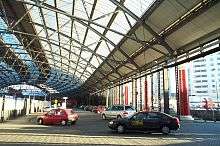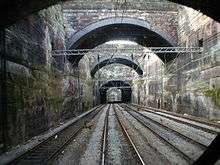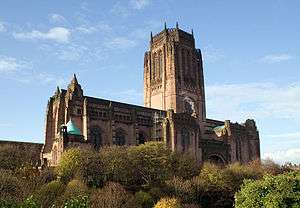Liverpool Lime Street railway station
| Liverpool Lime Street | |
|---|---|
|
The frontage at Liverpool Lime Street | |
| Location | |
| Place | Liverpool |
| Local authority | City of Liverpool |
| Coordinates | 53°24′27″N 2°58′42″W / 53.4075°N 2.9784°WCoordinates: 53°24′27″N 2°58′42″W / 53.4075°N 2.9784°W |
| Grid reference | SJ351905 |
| Operations | |
| Station code | LIV |
| Managed by |
Network Rail (mainline) Merseyrail (underground) |
| Number of platforms | 9 + 1 underground |
| DfT category |
A (mainline) D (underground) |
|
Live arrivals/departures, station information and onward connections from National Rail Enquiries | |
| Annual rail passenger usage* | |
| 2004/05 |
|
| 2005/06 |
|
| 2006/07 |
|
| 2007/08 |
|
| 2008/09 |
|
| 2009/10 |
|
| 2010/11 |
|
| 2011/12 |
|
| – Interchange | 0.778 million |
| 2012/13 |
|
| – Interchange |
|
| 2013/14 |
|
| – Interchange |
|
| 2014/15 |
|
| – Interchange |
|
| Passenger Transport Executive | |
| PTE | Merseytravel |
| Zone | C1 |
| History | |
| Original company | Liverpool and Manchester Railway |
| Pre-grouping | London and North Western Railway |
| Post-grouping | London, Midland and Scottish Railway |
| 15 August 1836 | Opened |
| 1977 | Underground station opened |
| National Rail – UK railway stations | |
| * Annual estimated passenger usage based on sales of tickets in stated financial year(s) which end or originate at Liverpool Lime Street from Office of Rail and Road statistics. Methodology may vary year on year. | |
|
| |

Liverpool Lime Street is a terminus railway station, and the main station serving the city centre of Liverpool. A large building resembling a château fronts the station. A branch of the West Coast Main Line from London Euston terminates at the station, as well as TransPennine Express trains and other train services. The underground Lime Street Wirral Line station on the Merseyrail network is accessed via the main terminus. Lime Street is the largest and oldest railway station in Liverpool, and is one of 19 stations managed by Network Rail.[1]
History
Construction and pre-war era
The original terminus of the 1830 Liverpool and Manchester Railway (L&MR) was located at Crown Street, in Edge Hill, to the east of and outside the city centre. A new station in the city centre was needed. Construction of a purpose-built station at Lime Street in the city centre began in October 1833, the land being purchased from Liverpool Corporation for £9,000. A twin track tunnel was constructed between Edge Hill and the new station prior to station construction in 1832 being used to transport building materials for the station. The architects were Cunningham and Holme,[2] with the station opening to the public in August 1836, although construction was not fully completed until the following year. Because of the steep incline uphill from Lime Street to Edge Hill, trains were halted at Edge Hill. Locomotives were removed from then train with the passenger carriages taken down by gravity, with the descent controlled by brakemen in a brake van. The return journey was achieved by using a stationary steam engine located at Edge Hill to haul the carriages up to Edge Hill by rope.
Within six years, the rapid growth of the railways required expansion of the original station. A plan was formed to erect an iron roof similar to that found at Euston station in London, a ridge roof supported by iron columns. However, Richard Turner and William Fairburn submitted a design for a single curved roof, which won the approval of the station committee. The work cost £15,000, and was completed in 1849.
In 1867 further expansion was needed and included the present northern arched train shed. With a span of 200 feet (61 m), it was the largest in the world at the time. It was also the first train shed in which iron was used throughout. A second parallel southern train shed was completed in 1879 being notable in being of dry construction with each bay taking only three days to construct.[3]
The station is fronted by a large building in the style of a French château, the former North Western Hotel. Designed by Alfred Waterhouse, the building was built in 1879 at the same time as the second train shed and is now accommodation for students of Liverpool John Moores University.
In 1845 the L&MR was absorbed by its principal business partner, the Grand Junction Railway (GJR); the following year the GJR became part of the London and North Western Railway. At 'the grouping' in 1923, the station passed to the ownership of the London, Midland and Scottish (LMS) railway, and in 1948, the London Midland Region of British Railways. The station was one of the first to send mail by train.
British Rail
In 1959, preparations began at Lime Street for the first stage of electrification of the West Coast Main Line.[4] On 1 January 1962, electric services between Lime Street and Crewe officially began.[5] In 1966, the station hosted the launch of the first InterCity service.
An office tower block named Concourse House and a row of small shops used to stand outside the southern train shed, obscuring the arches. These dated from the 1960s, and by the 2000s had become run down.[6] They were demolished as part of a comprehensive refurbishment completed in 2010.
With the creation of the Merseyrail urban rail network in the 1970s, four terminus stations were demolished in Liverpool and Birkenhead centres, leaving only Lime Street terminus as a central point to serve the whole region for medium- and long-haul routes. The Merseyrail network gave ease of access for the whole Merseyside region to the one remaining large terminus.
Privatisation
Lime Street was voted Station of the Year 2010 at the National Rail Awards.[7]
Completion of electrification of the former Liverpool and Manchester Railway's route and the line to Wigan via St Helens Central in May 2015, led to a recast of timetables. This included the introduction of a brand new TransPennine Express service to Newcastle Central via Manchester Victoria, running alongside the existing service to Scarborough via Warrington Central and Manchester Piccadilly. There were question marks as to whether suitable electric rolling stock would be available in time for the completion of the work,[8] but it was confirmed in April 2014 that electric trains would be available to operate the new electric services, and the first trains were introduced from March 2015, initially on the service to Manchester Airport, with services to Wigan North Western, Manchester Victoria and Warrington Bank Quay following suit over the course of the year.[9][10]
2017-18 station remodelling
A £340m remodelling of the station will take place from 2017.[11] This will create two new platforms between the existing platforms 7 and 8, with other platforms being lengthened and widened.[12][13] The remodelling will allow for new services to Glasgow, starting in 2019. A supermarket and new shops will also be built.[11] The station will close for nine days from 30 September 2017 and will also close in autumn 2018 (with dates yet to be confirmed).[13]
Station layout
Liverpool Lime Street is divided into two sections: the mainline station, which offers national inter-city and regional overground services including local City Line routes, and services on the Wirral Line on the Merseyrail network, located underground between the mainline station and St George's Hall.
Mainline station

The mainline station is still covered by the vast iron and glass roofs dating from the 1880s. Platforms 1 to 6 are shorter than 7 to 9, the latter dealing mainly with long-distance services to London, Birmingham, Leeds, Sheffield and Norwich. Access to platforms 1–6 is through a ticket inspection barrier similar to airport passport control, while platform 7 is now gated with the creation of new shops and facilities. Platforms 8 and 9 are still "open". Toilets, booking offices, shops, a left-luggage office, taxi ranks and coffee bars are amongst the facilities provided.
.jpg)
The main concourse features a pair of statues of Ken Dodd and Bessie Braddock, a work entitled "Chance Meeting" by sculptor Tom Murphy, unveiled by Ken Dodd in June 2009.[14]
In 2009, new buildings were erected in the old "cab road" area between platforms 7 and 8. These currently house customer lounges, the Virgin Trains customer service point, and an ATM, and there are retail units which have coffee shops amongst the units.
.jpg)


In line with Liverpool's role as European Capital of Culture in 2008, and the city's 800th anniversary in 2007, the station and its immediate surroundings received a £35 million redevelopment grant. The Lime Street Gateway Project saw the retail parade and office block in front of the station demolished, and an improved frontage and public plaza built. The development was overseen by English Partnerships and was completed in October 2010.[15]
As a rule of thumb, during the day:
- Platform 1 for Northern services to Manchester Airport and Wigan North Western
- Platform 2 for Northern services to Manchester Victoria
- Platform 3 for Northern services to Liverpool South Parkway
- Platform 4 for Northern services to Preston and Warrington Bank Quay
- Platforms 5 and 6 for East Midlands Trains services to Sheffield, Nottingham and Norwich, for the local stopper Northern Rail service to Manchester Oxford Road and for TransPennine Express fast services to Newcastle via Manchester Victoria
- Platform 7 for Virgin Trains services to London Euston
- Platform 8 for London Midland services to Birmingham New Street
- Platform 9 for TransPennine Express fast services to Manchester, Leeds, York and Scarborough and for Northern Rail semi-fast services to Manchester Oxford Road
Platforms are subject to change and diversions to a different platform are common, particularly when services arrive late or early.
Liverpool Lime Station platforms 1–5 are being fully refurbished by Network Rail. Platform 6 will be eventually straightened (as it is curved at present) as part of the station resignalling scheme due for completion in 2017.
There are also 4 non-passenger tracks.[16] Three of these are headshunts, created in the Northern trainshed to turn locomotives around: Track A, in between platforms 1 & 2; track B, serving platforms 3 & 4; & track D, for platforms 5 & 6. There is also a platform with no passenger service in between platforms 6 & 7, known as platform E, or sometimes affectionately as platform 6¾.
Services
The main station is currently served by five train operating companies serving a wide variety of destinations, but the service has been much reduced in recent times. For example, it is no longer possible to travel directly to Edinburgh, Plymouth, Southampton and Cardiff without changing trains. Services out of Lime Street (as of May 2016) are as follows:
.jpg)
East Midlands Trains
East Midlands Trains operate an hourly service to Norwich via Warrington Central, Manchester Piccadilly, Stockport, Sheffield and Nottingham. Late afternoon and evening services terminate or start at Nottingham.[17]
TransPennine Express
TransPennine Express operates an hourly service to Newcastle Central via Manchester Victoria, Leeds and York as well as an hourly service to Scarborough via Warrington Central, Manchester Piccadilly, Leeds and York. Late services start or terminate at York and Manchester Piccadilly.[18]
.jpg)
London Midland
London Midland operate a half hourly service to Birmingham New Street via Runcorn, Crewe, Stafford and Wolverhampton. Late services also terminate/start at Crewe or Stafford. A number of services are extended beyond Birmingham New Street to start or terminate at Walsall or Birmingham International.[19]
.jpg)
Northern
Northern is the main train operating company at Lime Street, operating the ticket office. Services include:
- Half hourly service to Manchester Oxford Road (via Warrington Central, most local stations)[21]
- Hourly service to Preston (limited stop)[22]
- Half hourly service to Wigan North Western (via St Helens Central, all stations)
- Hourly service to Manchester Victoria (via Newton-le-Willows, all stations)
- Hourly service to Manchester Airport (via Newton-le-Willows, limited stop)
- Hourly service to Warrington Bank Quay (via Earlestown, all stations)
- Hourly service to Liverpool South Parkway (extended from Preston)
.jpg)
Virgin Trains
Virgin Trains operate an hourly Pendolino service to London Euston calling at Runcorn, Crewe and Stafford (peak services call additionally at Lichfield Trent Valley, Tamworth, Nuneaton, Rugby, Milton Keynes Central and Watford Junction).[23]
| Preceding station | |
Following station | ||
|---|---|---|---|---|
| Terminus | East Midlands Trains Liverpool – Norwich |
Liverpool South Parkway | ||
| Terminus | TransPennine Express Liverpool – Newcastle |
Manchester Victoria | ||
| Terminus | TransPennine Express Liverpool – Scarborough |
Liverpool South Parkway | ||
| Terminus | London Midland Liverpool – Birmingham |
Liverpool South Parkway | ||
| Terminus | Northern Liverpool – Wigan |
Edge Hill | ||
| Northern Liverpool to Manchester Line |
||||
| Terminus | Northern Liverpool-Manchester Airport |
Wavertree Technology Park | ||
| Huyton | Northern Preston-Liverpool Line |
Liverpool South Parkway | ||
| Terminus | Virgin Trains WCML Liverpool Branch |
Runcorn | ||
| Future services | ||||
| Terminus | TBA High Speed 3 |
Manchester Victoria | ||
Proposed services
Scotland
As part of the TransPennine Express (TPE) franchise agreement (awarded to FirstGroup which started services in April 2016), there will be three new direct services per day to Glasgow Central via Preston along the West Coast main line.[24] The current hourly TPE Newcastle route will also be extended via Morpeth to Edinburgh Waverley.
In 2005 Renaissance Trains proposed a twice-daily service from Lime Street to Glasgow Central, with weekend trains running instead from Blackpool to Glasgow.[25][26] The proposal did not get enough investment backing, but was revived in 2014.[27]
Chester and North Wales via the Halton Curve
Proposals to upgrade the Halton Curve have been considered by, among others, Merseytravel and the North Cheshire Rail User's Group.[28] This would provide a second rail route between Liverpool and Chester, and would permit the introduction of new direct services from Liverpool to Wrexham, Llandudno and other parts of North Wales. In 2014, George Osborne, the Chancellor of the Exchequer, announced that £10.4m of funding had been found for the Curve to reopen. In May 2015, Merseytravel published the business case for the reopening of the curve and forecast one train per hour running along the curve from Liverpool Lime Street, initially to Chester but with the potential for running to Wrexham. This would give residents in Chester/Wrexham a direct train to Liverpool Airport and the service could be running by 2018.[29][30]
London Euston
It was also proposed by 2016 that London Midland will also operate an hourly service to London Euston (as an extension of its existing Trent Valley semi-fast service).
Leeds
As part of the new Northern franchise agreement (awarded to Arriva, which started in April 2016), from December 2017 there will be a new "Northern Connect" service to Leeds via Manchester Victoria and Bradford Interchange (replacing the current all-stations local service to Victoria).[31]
Withdrawn services
Certain direct trains to and from Liverpool Lime Street station have been withdrawn since 2000. These include the following services:
- Wales & West services to Cardiff and Milford Haven via the Welsh Marches.
- Virgin Trains Crosscountry services to Edinburgh, Poole, Weymouth, London Paddington, Portsmouth, Plymouth and Brighton.
- First North Western services to Chester via Warrington Bank Quay.
- Central Trains services to Cambridge and Stansted Airport.
In addition, former British Rail services to Scotland, Wrexham and other parts of North Wales, Bradford Interchange, Harwich and Leicester no longer operate.
Underground station
.jpg)
The underground station consists of a single platform, alongside the Liverpool Loop tunnel, a single track tunnel bored in the 1970s, and a ticket hall above. The station is connected to the mainline station by means of a pedestrian subway and escalators, accessed via a long passageway which crosses beneath Lime Street itself, and by a lift from the main concourse.
As part of a programme of improvements by Merseytravel, the underground station has been fitted with automatic ticket barriers and machines.
A new M to Go shop was opened in late 2011.
2013 refurbishment
Network Rail announced in early 2013 that Lime Street was to be the third station to be refurbished as part of the £40 million investment which would see all Merseyrail underground stations excluding Conway Park refurbished. This included the refurbishment of the platform and the booking hall. The station refurbishment work took place between April and August 2013.[32][33]
Subway refurbishment
The subway linking the underground station to the mainline station was refurbished in June 2014. The subway was fitted out with new tiles, lighting, flooring and automatic doors to some of the entrances.[34]
Recent history
The underground station had WiFi installed in January 2016.[35]
In March 2016, it was announced that the Wirral Line loop will be having its track renewed. The underground station will therefore be closed between 3 January 2017 and 18 June 2017 whilst these works take place.[36]
Services
Services operate on a 5-minute frequency Monday-Saturday, and between 5- and 10-minute frequency on Sundays in the winter. All trains travel through to Liverpool Central and Birkenhead of which:
- 4 trains per hour continue to New Brighton
- 4 trains per hour continue to West Kirby
- 4 trains per hour continue to Chester
- 2 trains per hour continue to Ellesmere Port
To reach destinations on the Northern Line of the network, passengers must either use the Wirral Line and change at Liverpool Central station or walk the short distance to the station.
| Preceding station | |
Following station | ||
|---|---|---|---|---|
| Moorfields (one-way operation) |
Merseyrail Wirral Line |
Liverpool Central towards New Brighton, West Kirby, Chester or Ellesmere Port | ||
References
- ↑ "Commercial information". Our Stations. London: Network Rail. April 2014. Retrieved 12 April 2014.
- ↑ "Basic Site Details – Lime Street Station". Dictionary of Scottish Architects. Retrieved 4 January 2015.
- ↑ "Lime Street Station". LiverpoolArchitecture.com. Archived from the original on 8 August 2004. Retrieved 30 April 2012.
- ↑ Cadwallader & Jenkins 2010, p. 55
- ↑ Cadwallader & Jenkins 2010, p. 56
- ↑ Hodgson, Neil (22 December 2007). "New design plans for Lime Street station". Liverpool Echo. Retrieved 22 November 2015.
- ↑ "Liverpool Lime Street voted nation's best station". wirralglobe.co.uk. Newsquest Media Group. 17 September 2010. Retrieved 19 September 2010.
- ↑ Cox, Charlotte (26 August 2013). "The next train for Liverpool... might not exist". Manchester Evening News. Retrieved 10 December 2013.
- ↑ "Northern Announces Electric Trains For North West". Northern Rail. 2 April 2014. Retrieved 6 July 2014.
- ↑ "Lime Street Station Stage Two Report" (PDF). liv.ac.uk. Retrieved 29 October 2015.
- 1 2 Hodgson, Neil (21 March 2016). "Merseyside train passengers will take the strain during £340m railway improvement work". Liverpool Echo. Retrieved 21 March 2016.
- ↑ Morby, Aaron (21 March 2016). "£340m railway upgrade planned for Liverpool". Construction Enquirer. Retrieved 21 March 2016.
- 1 2 Hodgson, Neil (21 March 2016). "Lime Street station faces nine day closure during revamp in 2017". Liverpool Echo. Retrieved 21 March 2016.
- ↑ "Ken Dodd & Bessie Braddock – Sculpture at Lime Street Station". Liverpool Monuments. Retrieved 5 January 2015.
- ↑ "Liverpool Lime Street Station, United Kingdom". railway-technology.com. Retrieved 15 June 2014.
- ↑ Trackatlas 2009. ISBN 978 1902336 97 8
- ↑ GB eNRT May 2016 Edition, Table 49 (Network Rail)
- ↑ GB eNRT May 2016 Edition, Table 39 (Network Rail)
- ↑ GB eNRT May 2016 Edition, Table 91 (Network Rail)
- ↑ "Electric services to Wigan and Manchester Victoria start in May". RAIL. Retrieved 1 June 2015.
- ↑ GB eNRT May 2016 Edition, Table 89 (Network Rail)
- ↑ GB eNRT May 2016 Edition, Table 90 (Network Rail)
- ↑ GB eNRT May 2016 Edition, Table 65 (Network Rail)
- ↑ "TransPennine Franchise Improvements: Liverpool". Department for Transport. Retrieved 3 March 2016.
- ↑ Briefing Concerning Glasgow Trains Proposal Renaissance Trains 18 October 2006
- ↑ "Renaissance for Glasgow-Nottingham" Rail Magazine issue 509 16 March 2005 page 12
- ↑ "About Renaissance Trains".
- ↑ "Halton Curve Campaign". North Cheshire Rail Users' Group. Retrieved 6 August 2009.
- ↑ "Halton Curve Outline Business Case" (PDF). Merseytravel. May 2015. Retrieved 29 October 2015.
- ↑ Barrett, Frances (13 July 2015). "Halton Curve rail line could be back in business in 2018". The Chester Chronicle. Retrieved 29 October 2015.
- ↑ "Northern Franchise Improvements". Department for Transport. Retrieved 3 March 2016.
- ↑ Siddle, John (3 September 2012). "Liverpool Lime Street closed as part of £40m Merseyrail upgrade". Liverpool Echo. Trinity Mirror Merseyside. Retrieved 10 February 2013.
- ↑ Weston, Alan (14 August 2013). "End of line for loop disruption". Liverpool Echo. Retrieved 20 September 2016.
- ↑ "Revamp of subway linking Lime Street stations set to begin". Merseytravel. 11 April 2014. Retrieved 29 October 2015.
- ↑ Hughes, Lorna (22 October 2015). "Merseyrail introduces free wifi at five underground stations". Liverpool Echo. Retrieved 3 March 2016.
- ↑ Wirral Track Renewal
Sources
- Cadwallader, Jonathan; Jenkins, Martin (2010). Merseyside Electrics. Ian Allan. ISBN 9780711034174. OCLC 455806364.
Further reading
- "Lime St. plan". Rail Enthusiast. EMAP National Publications. October 1982. p. 49. ISSN 0262-561X. OCLC 49957965.
- "Lime Street derailment". Rail Enthusiast. EMAP National Publications. February 1983. p. 50. ISSN 0262-561X. OCLC 49957965.
External links
| Wikimedia Commons has media related to Liverpool Lime Street railway station. |
- Station information for Liverpool Lime Street from Network Rail
- Station information for Liverpool Lime Street (Underground) from Merseyrail
.jpg)


